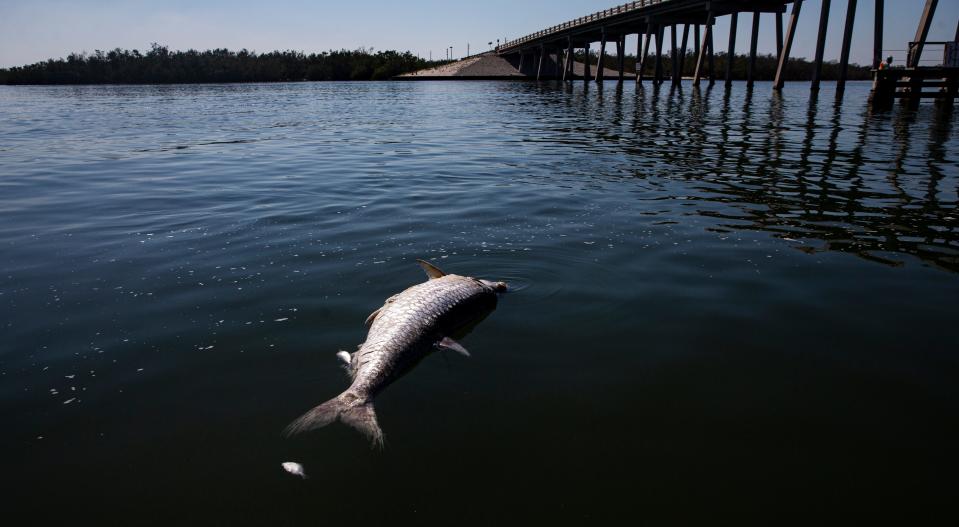Red tide numbers waning in Lee, Collier waters, still prevalent elsewhere in Gulf
The latest red tide to blanket Southwest Florida seems to be losing strength in Lee and Collier counties as the higher brevatoxin counts have been reported in the Tampa Bay area in recent days.
Background to medium levels of red tide (Karenia brevis) were reported across both counties to the Florida Fish and Wildlife Conservation Commission, the state agency charged with monitoring the deadly blooms.
Red tide occurs naturally in the eastern Gulf of Mexico but is fed by nutrients coming from farming operations and urbanized areas, science shows; and today blooms are stronger, longer in duration and more frequent than they were in the 1950s.
"They usually say October, November and December is the season, but now we’re pushing April and I’m wondering how much longer this could persist," Calusa Waterkeeper Emeritus John Cassani said.
Cold fronts and strong winds can break up red tide blooms, but this past winter has been quite mild, with only a handful of strong cold fronts making it to the region this year.
Red tide is also known for its ghostly ability to be in one location one day and completely gone the next.

"The Gulf is a big mixing zone and there are a lot of forces, winds and currents that move it around," Cassani said.
Levels can be deadly for fish and marine mammals once numbers reach 10,000 cells per liter. Counts in recent weeks have been as high as 20 million cells per liter off Sanibel Island, reports show.
From an algae bloom perspective, 2023 is being compared to 2018 as both came after a major hurricane hit Southwest Florida.
Irma in 2017 flooded the landscape and washed millions of tons of nutrients off the landscape. A red tide bloom started shortly after the storm, and it stayed in place for nearly two years.
The summer of 2018 was the peak of that bloom, with animals like dolphins, sea turtles and even whale sharks washing onshore.
Hurricane Ian hit the region last summer, and scientists like Mike Parsons at Florida Gulf Coast University say this winter's bloom has been worse than the one that set the table for the 2018 bloom.
More:Red tide numbers strong as fish kills reported throughout Naples, Collier County
More:Groups planning to fight any proposal for another black bear hunt in Florida
More:Lessons learned: Reporter recalls 12-day canoe trip through Everglades National Park
More:Feds planning a reservoir north of Lake Okeechobee, looking at other options
Like Irma, Ian flooded the landscape. The two storms were very different though as Irma was mostly a rain event while Ian brought 15 feet of storm surge and strong wind damage.
Red tide blooms tend to initiate in the late summer or early fall and disappear by late winter or early spring.
"It looks worse now than in March of 2018," Parsons told The News-Press last week. "It's really hard to say how it's going to project. We'll have to wait until June, July and August to see."
State health department offices in both Lee and Collier counties have issued swim advisories in recent weeks, warning the public of the dangers.
A potential treatment for red tide
University of Central Florida professor of biology Kristy Lewis is working on a project she and others hope will help stem red tide outbreaks.
The project uses clay flocculation, which attaches to the red tide organisms and causes them to sink to the ocean floor.
Lewis says the project, in Sarasota Bay, has been successful and that the treatment could be used elsewhere.
“We want to make sure the cure is not worse than the disease,” she says.
Connect with this reporter: Chad Gillis on Facebook.
This article originally appeared on Fort Myers News-Press: Red tide levels have gone from deadly to natural levels in Lee, Collier

